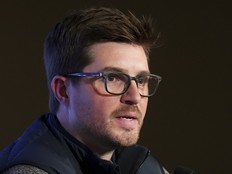Converse - not Nike - takes centre stage at NBA Finals with Thunder star

Article content
When the NBA Finals tip off on Thursday night, Shai Gilgeous-Alexander will be considered by many as the best player on the overwhelming favorite to win the championship.
And like many stars, SGA — as he’s known — will be wearing his own signature sneakers when his Oklahoma City Thunder face the Indiana Pacers. But the shoes won’t have a Nike swoosh or a Jordan logo — the brands that have long controlled the basketball sneaker market. Instead, he’ll be wearing Converse.
The brand’s Chuck Taylor sneakers were a force in hoops into the 1970s, but then morphed into a casual shoe as Nike Inc. gobbled up market share in basketball. But in SGA, Converse now has a superstar that could help it relive the glory days.
Meanwhile, Nike, which owns the Jordan brand, is in an unfamiliar position. The next biggest name in the series is Indiana’s Tyrese Haliburton, who has a shoe with Puma SE.
However, Nike isn’t being completely shut out of the finals. The world’s largest sports gear maker acquired Converse in 2003 to bolster its lifestyle business. Since then, Converse has had spurts of success, but growth stalled and revenue has been declining, including an 18% drop in the most recent reported period. It makes up about 4% of Nike’s total sales.
Nike Chief Executive Officer Elliott Hill, who came out of retirement last year to try to reverse a lengthy sales slump, recognizes the shoe’s importance. In February, Hill flew to San Francisco to be alongside SGA to debut the Shai 001 — his new $130 basketball shoes in buttery yellow.
“Footwear is all about endorsers and personalities, to be able to identify product lines, and customers know their products by their names rather than just calling them sneakers,” said Simeon Siegel, an analyst at BMO Capital Markets. “Converse knows this better than anyone. Go back to what made Converse: the Chuck Taylor.”
A representative for Converse didn’t respond to a request for comment for this story.
Long before Michael Jordan played his first NBA game, Converse’s Chuck Taylor sneaker was the most dominant shoe on the court. Nearly all pro basketball players throughout the 1960s wore Converse sneakers — usually Chucks, originally developed for the basketball player-turned-shoe salesman in the 1920s. Magic Johnson and Larry Bird, the top stars of the 80s, wore Converse as they battled for championships.
In the NBA, rivals such as Adidas AG and Puma seized market share, then Nike came along with its first Jordans in 1985 and never looked back. The majority of NBA players wear Nikes or Jordans, and it has signature shoes with most of the sport’s biggest names: LeBron James, Kevin Durant and Giannis Antetokounmpo. Converse was forgotten.
Unlikely Hero
SGA, a 6-foot-6 Canadian guard out of the University of Kentucky, is an unlikely hero for Converse. The Charlotte Hornets picked him 11th in the 2018 NBA Draft and traded him to the Los Angeles Clippers on the same day. After averaging about 11 points per game in his rookie year, the Clippers traded him to the Thunder.
The breakout came after SGA arrived in Oklahoma, and Converse finally signed him to a footwear and apparel endorsement deal in 2020 after his second season as a pro. He said at the time that Converse “not having so many guys and the ability to express myself on and off the court in so many different ways appeals to me so much.”
Three All-Star selections and one Most Valuable Player award later, SGA has emerged as one of the league’s elite talents.
But Converse’s timing could’ve been better. Though SGA began wearing his sneakers midway through the season, they won’t be available for shoppers to purchase until this fall.
Yet as Converse leans into basketball, Hill and Converse Chief Executive Officer Jared Carver have yet to outline a strategic plan to turn around the brand. It’s rarely mentioned on Nike’s quarterly calls with investors and analysts.
“Converse as a standalone business is very large,” said Siegel. “As a piece of Nike, it’s felt like an afterthought.”











Postmedia is committed to maintaining a lively but civil forum for discussion. Please keep comments relevant and respectful. Comments may take up to an hour to appear on the site. You will receive an email if there is a reply to your comment, an update to a thread you follow or if a user you follow comments. Visit our Community Guidelines for more information.